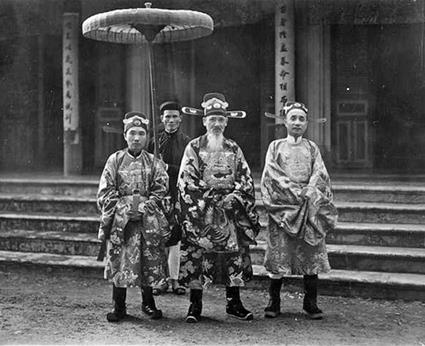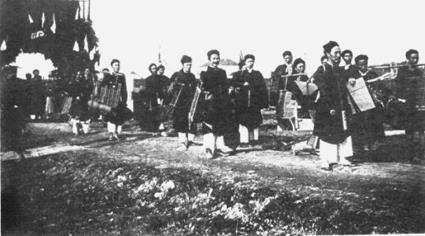Pham Diem
State and Law Institute of Vietnam
In Vietnam, the feudal regime went through thousands of years of existence and development. The feudal law was one of the most fundamental and prominent achievements of various dynasties, which was diverse in form and rich in content, governing most all aspects of the social life then.
The feudal law, customs and practices and Confucian code of conduct created social norms regulating conducts of people, from mandarins to commoners, thus greatly contributing to the maintenance of the royal power as well as social order, national peace and stability. Moreover, the feudal law in Vietnam, especially “Quoc Trieu Hinh Luat” (The National Royal Criminal Code of the late Le Dynasty) of the 15th century, was characterized by many special features in both legislative skills and content.
Harmonious combination between the law and customs and practices
In any country and at any time, the law, morality, customs and practices are always inter-related, complementing and supporting one another in regulating social relations. Like in other oriental countries such as China, Korea and Japan, which shared the system of Confucian thoughts, the moral codes of Confucianism was considered orthodox and institutionalized by the feudal regimes in Vietnam. Yet, besides these moral codes, there also existed in the country the native codes of Vietnamese morality, which were established very early and existed through thousands of years of the nation’s history, playing the leading role in regulating social relations in village communities. Many traditional moral codes have been crystallized into sustainable customs and practices.
The special feature of the Vietnamese feudal law is not the combination between law and customs as well as practices but consists in the condensation, sharpness, harmony and reasonableness of such combination manifested in the following aspects:
First, many legal norms were the outcome of such combination, particularly those regulating marriage and family relations and property relations. In other words, in the legislative process, Vietnamese feudal lawmakers attached great importance to time-honored traditions and practices. Most legal provisions on marriage and divorce, family ties, contracts of various types or relations of inheritance contained more or less folk customs and practices.
Second, Vietnamese feudal lawmakers rationally selected customs and practices for codification. Only the most common customs and practices which were directly related to social order and discipline, could be made into law, for instance, the traditional customs and practices on harmonious and sustainable families where exists the hierarchy of family relationshíps, under which children and grandchildren must be dutiful and show filial piety to their parents and grandparents while the latter have the duty to raise the former; the customs and practices on gratitude towards, and worship of, ancestors.
Third, many important social relations were not put into law, but left for regulation by customs and practices. They were social relations which had been regulated by customs and practices for long and varied from locality to locality. For instance, the legal consequences of divorce, namely the division of property and the raising of children after the divorce, were not mentioned in law. Realities show that as long as they were not contrary to state law and discipline as well as moral principles, long-established customs and practices were more effective than law. Whereas, legal provisions that are contrary to customs and practices hardly enter life.
It can be said that Vietnamese feudal lawmakers attached great importance to traditional customs and practices and handled the relationship between state law and customs and practices in a harmonious, reasonable and effective manner.
Special features in procedural institutions
The social relations under the Vietnamese feudal regimes underwent many ups and downs due to natural disasters, foreign invasions and civil wars. People living in villages were closely bound to one another in the community relations while still witnessing quite a few conflicts of interest in the communities. Corruption, harassment for bribes and oppression of innocent people were common. Such a social environment gave rise to numerous lawsuits, thus prompting the feudal dynasties to pay attention to the making of procedural laws. Typical was a decree enacted by King Le Du Tong in 1718, which said: “Politics is best rooted with less lawsuits. Though laws were adequate, lawsuits filed by people were on the rise while many mandarins handled them carelessly and did not attempt to find ways to reduce them. This must be corrected. Now that former rules must be reviewed and revised before promulgation in order to minimize lawsuits.”
In the Vietnamese feudal legal system, legal proceedings were not only prescribed comprehensively and specifically in a number of chapters of various codes such as “Quoc Trieu Hinh Luat” in the 15th century and “Hoang Viet Luat Le” (The Royal Laws and Regulations of Vietnam) in the early 19th century, but also codified in a separate procedural code, that was “Quoc Trieu Kham Tung Dieu Le” (The Procedural Regulations of Royal Dynasties) in the 18th century.
“Quoc Trieu Kham Tung Dieu Le” is an extraordinary phenomenon in the history of Vietnamese feudal law and also a rare legal document in the world legal history. Having attached great importance to procedural law, especially the compilation of a separate procedural code, Vietnamese feudal lawmakers distinguished, to a given extent, procedural law from substantive law. Truly, this is a novelty of the Vietnamese feudal law, which was neither seen in the feudal Chinese law nor the laws of other pre-capitalist countries and came closer to the legal perception of the subsequent modern time.
The procedural institutions in the Vietnamese feudal law were especially prominent not only with the new perception of the position of the procedural law but also with their special contents.
The procedural provisions, especially in the “Quoc Trieu Kham Tung Dieu Le”, were systematic, comprehensive and very specific, from the procedural order and competence of different authorities to the various processes in the legal proceedings, including the lawsuit-filing procedures, case-processing procedures, scene-inspection procedures, arrest procedures, adjudication procedures, and judgment execution procedures.
Particularly, the procedural law spelt out many special provisions to prevent unnecessary minor complaints, improper filing of lawsuits and prolonged lawsuits. For instance, it provided that if people filed lawsuits in contravention of law, they would be subject to not only punishment but also heavy fines; or if judges accepted cases ultra vires, delayed the adjudication, or handed down unjust sentences, they would all be prosecuted and fined.
Special features in civil institutions
The feudal law of China and the laws of many other pre-capitalist countries only attached importance to the public law, but not to the private law - the civil law. Therefore, they neither contained specific provisions on forms of, and modes of formulating, contracts as well as inheritance testaments, nor clearly defined the regime on property between husband and wife.
Meanwhile, the Vietnamese feudal lawmakers, especially under the late Le dynasty, attached great importance to not only the public law but also the private law. “Quoc Trieu Hinh Luat” and many other legal documents prescribed in a comprehensive, clear and specific manner the ways of formulating legal documents, testaments, contracts, as well as the regime on property between husband and wife, the mode of heritage division, etc.. Thanks to this specific feature and the practicality of those provisions, various Vietnamese courts during the French-ruled period or the Court of Appeal of the former US-backed Saigon administration based themselves on the “Quoc Trieu Hinh Luat” to adjudicate cases related to property between husband and wife.
In the world legal history, the civil law was established and became the core in the legal system only during the Western capitalist time, when human rights and civic rights were mentioned and protected. Therefore, it can be said that the attachment of importance to private law was also a novelty of the Vietnamese feudal law.
The above-mentioned special features of the Vietnamese feudal law were not only agreed upon by many Vietnamese scholars but also highly valued by various foreign scholars. Right early in the 20th century “Quoc Trieu Hinh Luat” was translated into French. In the foreword, the translator highly valued the creation of Vietnamese law under the Le dynasty, though the Code bore the influences of Chinese feudal law and philosophy. The Code was also translated into English by the Harvard University with the following remark in the foreword of the translation: “We realize the effort of Vietnam under the Le dynasty, a constant effort in building a nationalist state and protecting lawful private ownership under a progressive legal system with many functional similarities to contemporary Western legal conceptions.” Two Japanese scholars, M. Aikyo and T. Inaco, in their book “Vietnamese legal research”, also commented: “Vietnamese law in the past is resolutely not identical with the Chinese feudal law. Though being affected by the laws and regulations of the Chinese Tang dynasty, Vietnam’s “Quoc Trieu Hinh Luat” of the 15th century bears the Vietnamese own traits. Unlike the Chinese law, it distinguished the substantive law from the procedural law and separated the family law from the civil law and the administrative law, and recognized the property rights of women”.-

